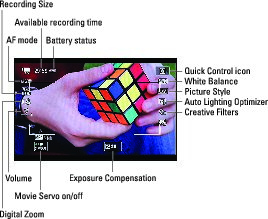Canon 80d Picture Style Setting
This information is from a Canon 7D but is relevant to most of the DLSR line with the Picture Styles settings. From the left, those symbols represent the setting for. Canon and Nikon also claim that a lens-based anti-shake system is inherently better too, but the jury's out on that one. The Canon EOS 80D offers fast, positive autofocus, which can track moving subjects very well and which is also near-silent. Canon 80D Experience 3 Canon 80D Experience - PREVIEW The Still Photography Guide to Operation and Image Creation with the Canon EOS 80D by: Douglas J.
Nov 14, 2018 - Ableton Live 10 Crack has comes with fresh plugins, workflow enhancements, along with a selection of additional features. Nov 8, 2018 - Overview: Ableton Live 10.0.5 Crack is a fantastic sound instrument which assists the end users to generate distinct musical compositions, edit. Nov 5, 2018 - Check out the How to Download, Install & Authorize Ableton Live 10. Click the image above to enter your Registration Code with Ableton! Live Versions: 9-10 Operating System: All Authorizing Ableton products Before. That you have registered the Live serial number in your Ableton user account. Ableton live 10 registration code.
The Shooting Information display mode on your EOS 80D presents a thumbnail of your image along with scads of shooting data. You also see a Brightness histogram — the chart-like thingy on the top right of the screen. (Remember, just press the Info button to cycle through the display modes to see this one.)
How much data you see, though, depends on the exposure mode you used to take the picture. The screen on the left shows the data dump that occurs when you shoot in the advanced exposure modes, where you can control all the settings indicated on the playback screen. When you shoot in the other exposure modes, you get a far-less detailed playback screen.
If you’re interested in the Shooting Information display mode, you’re probably shooting in the advanced exposure modes, so the rest of this information concentrates on that level of playback data. To that end, it helps to break the display into two main areas: the upper portion of the display, which contains general photo information, the thumbnail, and histogram, and the bottom half of the display, which contains several scrollable pages of detailed information.
The top portion of the display contains a wealth of information. The top row contains the same information as shown in the top row of the Basic Information display. Beneath that is a thumbnail of the photo or movie, the date and time it was taken, and the histogram.

By default, the bottom area of the screen initially shows this information:
- Detailed information: This view, shown first by default, contains detailed shooting information.
If a data item doesn’t appear on your monitor, it simply means that the feature wasn’t enabled when you captured the photo.
In particular, each row contains the following information:- Row 1 data: This row displays most of the same data as the bottom row of the Basic Information display mode, plus the Shooting (Exposure) mode.
- Row 2 data: These values relate to color settings. If you used flash without any Flash Exposure Compensation, you see just the lightning bolt symbol.
- Row 3 data: The bottom row holds the information you see below.
Several other symbols may appear on the bottom row, depending on whether or not you used HDR shooting, Multi Shot Noise Reduction, multiple-exposures, time-lapse movie images, cropped, processed, or applied Creative Filters to an image.
To reveal further information, use the up or down Multi-controller keys. You can also swipe vertically over the data with your finger (swiping horizontally over the photo thumbnail advances to the next or prior photo or movie). Here’s what you’ll find if you continue:
- Lens/histogram information: This page shows detailed information about the lens you’ve mounted and the second type of histogram. You’ll see the brightness histogram on this page unless you change the Histogram Disp option in Playback Menu 3.
- White balance information: This page shows white balance information. The setting name, symbol, and the amount of correction you may have dialed in are shown beneath the photo thumbnail. The white balance grid, which occupies the lower‐right area of the display, graphically shows the amount of correction applied to the photo.


- Picture Style information: The Picture Style information pages show the current Picture Style and detailed settings. The information takes up two pages.
- Color space/noise reduction information: This page lists three bits of information. First, the color space you have assigned is shown. Beneath that are the current noise reduction settings.
Canon Picture Style
- Lens Aberration Correction information: This page summarizes the lens correction options that were set on your camera when you took the photo.
Canon 80d Setting For Sports
- GPS information (not shown): If you shot photos with the separately sold GPS Receiver GPS-E2, you see a page with GPS information such as the location, elevation, direction, and precise time the photo was taken.
- 2Introduction
- 3Item Check List
- 4Instruction Manuals
- 5Compatible Cards
- 6Quick Start Guide
- 8Conventions Used in This Manual
- 9Chapters
- 10Table of Contents
- 17Index to Features
- 20Safety Precautions
- 23Handling Precautions
- 26Nomenclature
- 28Lcd Panel
- 29Viewfinder Information
- 33Getting Started
- 34Charging the Battery
- 36Installing and Removing the Battery
- 37Installing and Removing the Card
- 38Release Shutter Without Card
- 40Using the LCD Monitor
- 41Turning On the Power
- 42Battery Level Indicator
- 43Setting the Date, Time, and Zone
- 46Selecting the Interface Language
- 47Attaching and Detaching a Lens
- 48Detaching the Lens
- 49Basic Operation
- 50Shutter Button
- 50Pressing Halfway
- 51Mode Dial
- 51Main Dial
- 54Multi Function Lock
- 55Exposure
- 56Q Quick Control for Shooting Functions
- 58Menu Operations
- 61Using the Touch Screen
- 64Before You Start
- 64Formatting the Card
- 66Disabling the Beeper
- 66Setting the Power-off Time/Auto Power Off
- 67Setting the Image Review Time
- 67Turning the LCD Monitor Off/On
- 68Reverting the Camera to the Default Settings
- 69Exposure
- 71Displaying the Grid
- 72Q Displaying the Electronic Level
- 73Electronic Level
- 74Displaying the Flicker Detection
- 75Feature Guide and Help
- 76Help
- 77Basic Shooting
- 78A Fully Automatic Shooting (Scene Intelligent Auto)
- 80Exposure
- 81A Full Auto Techniques (Scene Intelligent Auto)
- 82A Live View Shooting
- 82The Lcd Monitor
- 83Disabling Flash
- 84C Creative Auto Shooting
- 888: Special Scene Mode
- 89P Shooting Food
- 90C Shooting Children
- 91Shooting Candlelight Portraits
- 92Shooting Night Portraits (With a Tripod)
- 93F Shooting Night Scenes (Handheld)
- 94G Shooting Backlit Scenes
- 95Shooting Portraits
- 96Shooting Landscapes
- 97Shooting Close-ups
- 98Shooting Moving Subjects
- 100Exposure
- 101Applying Creative Filters
- 102Select a Shooting Mode
- 103Soft Focus
- 106Q Quick Control
- 108Shooting With Ambience Selection
- 112Shooting By Lighting or Scene Type
- 115Setting the AF and Drive Modes
- 116F: Selecting the AF Operation
- 117Exposure
- 120S Selecting the AF Area and AF Point
- 122AF Point Selection
- 124AF Area Selection Modes
- 127AF Sensor
- 128Lenses and Usable AF Points
- 136When Autofocus Fails
- 137MF: Manual Focus
- 138Selecting the Drive Mode
- 140Using the Self-timer
- 141Image Settings
- 142Setting the Image-Recording Quality
- 144Raw Images
- 145Maximum Burst
- 146Changing the Image's Aspect Ratio
- 147LCD Monitor
- 148I: Setting the ISO Speed for Still Photos
- 150Iso Auto
- 154A Selecting a Picture Style
- 157A Customizing a Picture Style
- 159Filter Effect
- 160A Registering a Picture Style
- 162Setting the White Balance
- 163White Balance
- 163Q Setting the Auto White Balance
- 164O Custom White Balance
- 166P Setting the Color Temperature
- 167White Balance Correction
- 168White Balance Auto Bracketing
- 169Auto Correction of Brightness and Contrast
- 170Setting Noise Reduction
- 174Highlight Tone Priority
- 175Correction of Lens Peripheral Illumination and Aberrations
- 179Reducing Flicker
- 181Setting the Color Space
- 182Creating and Selecting a Folder
- 183Selecting a Folder
- 184File Numbering Methods
- 185LCD Monitor
- 186Setting Copyright Information
- 189Advanced Operations
- 190D: Program AE
- 191Program Shift
- 192S: Shutter-Priority AE
- 194F: Aperture-Priority AE
- 195Depth-of-Field Preview
- 196A: Manual Exposure
- 198Selecting the Metering Mode
- 200O Setting Exposure Compensation
- 201Auto Exposure Bracketing (AEB)
- 203A AE Lock
- 203Ae Lock Effects
- 204F: Bulb Exposures
- 205Bulb Timer
- 207W: HDR (High Dynamic Range) Shooting
- 212P Multiple Exposures
- 219Mirror Lockup
- 220Using the Eyepiece Cover
- 221F Using a Remote Switch
- 221R Remote Control Shooting
- 223Interval Timer Shooting
- 227Flash Photography
- 228D Using the Built-in Flash
- 233D Using an External Speedlite
- 235Setting the Flash
- 243Clear Settings
- 244Wireless Flash Photography
- 255Shooting With the LCD Monitor (Live View Shooting)
- 256A Shooting With the LCD Monitor
- 257LCD Monitor
- 264Shooting Function Settings
- 266U Applying Creative Filters
- 269LCD Monitor
- 270Menu Function Settings
- 274Selecting the AF Operation
- 276Focusing With AF (AF Method)
- 281LCD Monitor
- 286X Shooting With the Touch Shutter
- 288MF: Focusing Manually
- 293Shooting Movies
- 294K Shooting Movies
- 297Scene Icons
- 298Manual Exposure
- 300Information Display
- 302Still Photo Shooting
- 304Shooting Function Settings
- 306Setting the Movie Recording Size
- 307Movie Recording Size
- 311Using Movie Digital Zoom
- 312Setting the Sound Recording
- 314Shooting HDR Movies
- 316V Shooting Movies With Creative Filters
- 318Miniature Effect Movie
- 319N Shooting Time-lapse Movies
- 322LCD Monitor
- 326Menu Function Settings
- 329Movie Servo AF Speed
- 330Sensitivity
- 333Shooting Video Snapshots
- 343LCD Monitor
- 345Image Playback
- 346X Image Playback
- 347Shooting Information Display
- 347Grid Display
- 348B: Shooting Information Display
- 351Highlight Alert
- 353X Searching for Images Quickly
- 355U/y Magnified View
- 356D Playing Back With the Touch Screen
- 357LCD Monitor
- 358B Rotating the Image
- 359Setting Ratings
- 361Q Quick Control for Playback
- 363K Enjoying Movies
- 365K Playing Back Movies
- 367X Editing a Movie's First and Last Scenes
- 369Slide Show (Auto Playback)
- 371Start the Slide Show
- 373Viewing Images On a TV Set
- 376K Protecting Images
- 378L Erasing Images
- 380W Digital Print Order Format (DPOF)
- 383Print Ordering
- 384P Specifying Images for a Photobook
- 386Changing Image Playback Settings
- 387Auto Rotation of Vertical Images
- 389Post-Processing Images
- 390R Processing RAW Images With the Camera
- 395S Resizing JPEG Images
- 397N Cropping JPEG Images
- 399U Applying Creative Filters
- 401Miniature Effect
- 403Sensor Cleaning
- 404F Automatic Sensor Cleaning
- 405Appending Dust Delete Data
- 406Dust Delete Data
- 407Manual Sensor Cleaning
- 409Customizing the Camera
- 410Setting Custom Functions
- 411Custom Functions
- 413Custom Function Settings
- 415Safety Shift
- 416C.Fn II: Autofocus
- 425C.Fn III: Operation/Others
- 427Fine Adjustment of AF's Point of Focus
- 433Custom Controls
- 440Registering My Menu
- 442Enter Text
- 445W: Registering Custom Shooting Modes
- 449Reference
- 450B Button Functions
- 452Checking the Battery Information
- 456Using a Household Power Outlet
- 457H Using Eye-Fi Cards
- 460Function Availability Table By Shooting Mode
- 468System Map
- 470Menu Settings
- 471Software
- 481Troubleshooting Guide
- 493Software
- 496Error Codes
- 497Specifications
- 511Downloading Images to a Computer
- 512Software Start Guide
- 514Downloading and Viewing the Software Instruction Manuals (PDF Files)
- 516Downloading Images With a Card Reader
- 517Index
